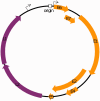The Papillomavirus Episteme: a central resource for papillomavirus sequence data and analysis
- PMID: 23093593
- PMCID: PMC3531071
- DOI: 10.1093/nar/gks984
The Papillomavirus Episteme: a central resource for papillomavirus sequence data and analysis
Abstract
The goal of the Papillomavirus Episteme (PaVE) is to provide an integrated resource for the analysis of papillomavirus (PV) genome sequences and related information. The PaVE is a freely accessible, web-based tool (http://pave.niaid.nih.gov) created around a relational database, which enables storage, analysis and exchange of sequence information. From a design perspective, the PaVE adopts an Open Source software approach and stresses the integration and reuse of existing tools. Reference PV genome sequences have been extracted from publicly available databases and reannotated using a custom-created tool. To date, the PaVE contains 241 annotated PV genomes, 2245 genes and regions, 2004 protein sequences and 47 protein structures, which users can explore, analyze or download. The PaVE provides scientists with the data and tools needed to accelerate scientific progress for the study and treatment of diseases caused by PVs.
Figures




References
-
- de Villiers EM, Fauquet C, Broker TR, Bernard HU, zur Hausen H. Classification of papillomaviruses. Virology. 2004;324:17–27. - PubMed
-
- Trottier H, Franco EL. The epidemiology of genital human papillomavirus infection. vaccine. 2006;24(Suppl. 1):S1–15. - PubMed
-
- Bouvard V, Baan R, Straif K, Grosse Y, Secretan B, El GF, Benbrahim-Tallaa L, Guha N, Freeman C, Galichet L, et al. A review of human carcinogens—Part B: biological agents. Lancet Oncol. 2009;10:321–322. - PubMed
-
- Garcia-Vallve S, Alonso A, Bravo IG. Papillomaviruses: different genes have different histories. Trends Microbiol. 2005;13:514–521. - PubMed
Publication types
MeSH terms
Substances
Grants and funding
LinkOut - more resources
Full Text Sources
Other Literature Sources
Molecular Biology Databases
Research Materials

